The Yu-Gi-Oh! TCG has many card effects that activate when a monster is summoned. The basic process is simple enough, but the retention of priority, use of counter traps, and vast amount of trigger effects have created an environment in which players put much more thought into the act of summoning a monster. You need to understand what happens when a monster is summoned, or you may make an unintentional mistake or miss out on the opportunity to interfere with your opponent’s plans.
The Successful Summon
When a monster is normal summoned, its effects don’t activate until the summon is successful. The normal summon is broken into two parts to handle this, because we get a chance to activate effects that negate the summon in one chain and effects that activate in response to the summon in another chain. We only get one chain for each, which limits the range of our reactions.
If I normal summon Zure, Knight of Dark World and my opponent attempts to negate the normal summon with Forced Back, I am allowed to chain another counter trap like Counter Counter to negate it. If I do so and negate my opponent’s counter trap, he or she can’t start another chain with a different effect to try and negate the same summon. Counter traps tend to activate in immediate response to the effect or action they intend to counter, and cards that negate summons are no exception.
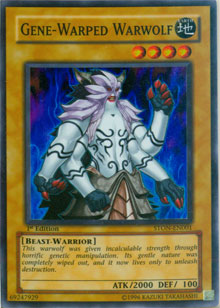 Example:
Example:
Player A has Gene-Warped Warwolf in his hand and Seven Tools of the Bandit set in his spell and trap card zone. Player B has Forced Back and Solemn Judgment set in her spell and trap card zone.
Player A normal summons Gene-Warped Warwolf. Player B activates Solemn Judgment to negate the summon, to which Player A responds with Seven Tools of the Bandit. Player B cannot activate Forced Back because she needs to activate a counter trap that would negate Seven Tools of the Bandit, which Forced Back cannot.
If the monster you are normal summoning has a continuous effect that is applied while it is face up on the field, or a trigger effect that activates when it is normal summoned, the effect is not applied until the summon is successful. A monster’s summon is considered successful when the summon has not been negated by cards like Forced Back or Horn of Heaven. This is why Jinzo cannot stop you from negating his normal summon with a counter trap card. His continuous effect isn’t applied until his summon is successful, so he has no way to prevent the counter trap card from activating.
Trigger effects are the same way, both those carried by the monster being summoned and cards already present on the field. When you normal summon
Armageddon Knight and your opponent negates the summon, the trigger effect of
Armageddon Knight doesn’t activate. It needed to be summoned successfully before its effect could be triggered.
Tribute summons work in the same way, with only the added addition of tributes offered from your side of the field as required by the level of the monster you are tribute summoning. The tributes are offered just to attempt the normal summon, and you don’t get the monsters back if the summon isn’t successful.
Continuous Effects and Trigger Effects
After your monster is successfully summoned, any continuous effects it has that are active while it is face up on the field are applied. The continuous effects of cards already on the field are also applied. These continuous effects are applied before either player can activate effects that respond to the summon, like Torrential Tribute.
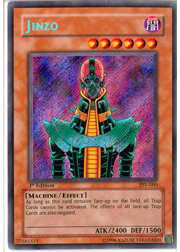
Example:
Player A tribute summons Jinzo. Player B has Bottomless Trap Hole set, but she cannot activate it because Jinzo’s continuous effect is now being applied.
Cards that can only be activated when a monster with specific ATK or DEF values is summoned must wait until after continuous effects are applied, before determining if they can be activated. Sometimes these continuous effects will alter the ATK or DEF of the summoned monster and place it into the proper range for your cards, while other times they will put it out of range. The application of these continuous effects doesn’t prevent you from activating effects in response to the summon, but it can affect which cards you would consider using.

Example:
Player A has Burden of the Mighty face up in his spell and trap card zone, and Bottomless Trap Hole set. Player B normal summons Gil Garth. First, the continuous effect of Burden of the Mighty is applied, reducing the ATK of Gil Garth from 1800 to 1400. Player A cannot activate Bottomless Trap Hole because Gil Garth’s ATK is too low.After the continuous effects, any trigger effects on the field that respond to the summon will activate and start a chain. When multiple trigger effects activate in response to the same summons, they form a chain following the rules for simultaneous effects. After the trigger effects are added to the chain, both players can activate new effects. Cards like
Torrential Tribute can still be activated at this time, because this entire chain is used to respond to the summon.
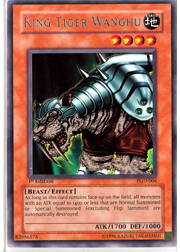 Example: One Trigger Effect
Example: One Trigger Effect
Player C has Acidic Downpour face up in his field spell card zone. He also has King Tiger Wanghu in face-up attack position. Player D has Enraged Muka Muka and one other card in his hand. Player D Tribute summons Enraged Muka Muka.
When Enraged Muka Muka is summoned, both its continuous effect and the continuous effect of Acidic Downpour are applied. Enraged Muka Muka gains 400 ATK and DEF with its effect, but also loses 500 ATK from Acidic Downpour. Its total ATK is 1100. Now that the continuous effects have been applied, King Tiger Wanghu’s trigger effect checks to see if the summoned monster’s ATK falls into the range for its effect. Enraged Muka Muka’s ATK is low enough, so King Tiger Wanghu’s effect activates.
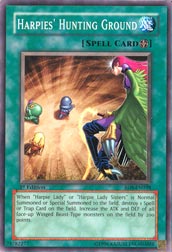 Example 2: More Trigger Effects
Example 2: More Trigger Effects
Player E has Level Limit - Area B face up in his spell and trap card zone. Player F has Harpies’ Hunting Ground face up in her field spell card zone and Mysterious Puppeteer in face-up defense position. Player F normal summons Harpie Lady 1.
First, the continuous effects of Level Limit - Area B, Harpies’ Hunting Ground, and Harpie Lady 1 are applied. Harpie Lady 1 is shifted into defense position and it gains 500 ATK. Now that the continuous effects have been applied, the trigger effects of Harpies’ Hunting Ground and Mysterious Puppeteer activate and are placed onto a chain. Harpies’ Hunting Ground can destroy Level Limit - Area B, but Harpie Lady 1 is already shifted into defense position.
Example 3: 1 — 2 — 3
Following our previous example, this time Player E also has Torrential Tribute set.
When Player F normal summons her Harpie Lady 1, the Harpie Lady 1 is shifted into defense position by Level Limit - Area B and she gains 500 ATK. Next, the trigger effects of Mysterious Puppeteer and Harpies’ Hunting Ground activate, starting a chain. After Player F decides the order for these two effects, Player E can activate Torrential Tribute.
Trigger effects tend to come in two varieties: mandatory effects you must activate when a specific event occurs or optional effects you can choose to activate or pass on when a specific event occurs. The optional trigger effects usually include "you can," letting you know that you aren’t forced to use the effect. When mandatory trigger effects and optional trigger effects activate simultaneously, the mandatory trigger effects are placed onto the chain first, followed by the optional trigger effects. After the trigger effects have been arranged onto the chain, you can activate effects that respond to the summon. Continuous effects, as in our previous examples, are applied before these trigger effects start a chain.
These chains can become complicated, but understanding them aids you quite well in understanding all chains with simultaneous effects.
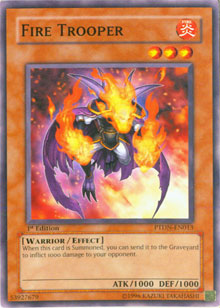
Example 1: Mandatory and Optional Effects
Player A has Stumbling face up in his spell and trap card zone. Player B normal summons Fire Trooper.
Stumbling has a mandatory trigger effect that activates when a monster is normal summoned.
Fire Trooper has an optional trigger effect that can be activated at the time it is normal summoned. If Player B activates its effect, both effects are placed onto a chain.
Stumbling is placed first because it is the mandatory trigger effect, and
Fire Trooper is placed second because it is the optional trigger effect.
Example 2: Continuous, Mandatory, and Optional Effects
Player A has Marauding Captain in his hand. He also has Command Knight in face-up defense position. Player B has Ancient Gear Castle face up and Bottomless Trap Hole set in her spell and trap card zone. Player A normal summons Marauding Captain and declares that he will activate its effect.
First, the continuous effect of Command Knight is applied, increasing Marauding Captain’s ATK to 1600. Next, the trigger effects start a chain, with the mandatory effect, Ancient Gear Castle, placed first onto the chain, followed by the optional trigger effect, Marauding Captain. Player B then activates Bottomless Trap Hole.
When the chain resolves, Bottomless Trap Hole removes Marauding Captain from play. Next, Marauding Captain’s effect special summons a level 4 or lower monster from Player A’s hand. Finally, Ancient Gear Castle gains a counter.
Next week we will examine how these rules work for flip summons. We will also take a look at what it means to "retain priority" when we normal summon or flip summon our monster.
Until then, send all comments and questions to Curtis@Metagame.com!